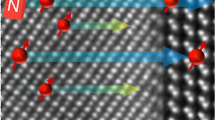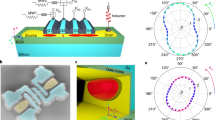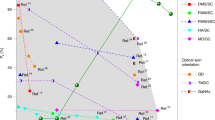Abstract
The control and manipulation of the electron spin in semiconductors is central to spintronics1,2, which aims to represent digital information using spin orientation rather than electron charge. Such spin-based technologies may have a profound impact on nanoelectronics, data storage, and logic and computer architectures. Recently it has become possible to induce and detect spin polarization in otherwise non-magnetic semiconductors (gallium arsenide and silicon) using all-electrical structures3,4,5,6,7,8,9, but so far only at temperatures below 150 K and in n-type materials, which limits further development. Here we demonstrate room-temperature electrical injection of spin polarization into n-type and p-type silicon from a ferromagnetic tunnel contact, spin manipulation using the Hanle effect and the electrical detection of the induced spin accumulation. A spin splitting as large as 2.9 meV is created in n-type silicon, corresponding to an electron spin polarization of 4.6%. The extracted spin lifetime is greater than 140 ps for conduction electrons in heavily doped n-type silicon at 300 K and greater than 270 ps for holes in heavily doped p-type silicon at the same temperature. The spin diffusion length is greater than 230 nm for electrons and 310 nm for holes in the corresponding materials. These results open the way to the implementation of spin functionality in complementary silicon devices and electronic circuits operating at ambient temperature, and to the exploration of their prospects and the fundamental rules that govern their behaviour.
This is a preview of subscription content, access via your institution
Access options
Subscribe to this journal
Receive 51 print issues and online access
$199.00 per year
only $3.90 per issue
Buy this article
- Purchase on Springer Link
- Instant access to full article PDF
Prices may be subject to local taxes which are calculated during checkout





Similar content being viewed by others
References
Žutić, I., Fabian, J. & Das Sarma, S. Spintronics: fundamentals and applications. Rev. Mod. Phys. 76, 323–410 (2004)
Chappert, C., Fert, A. & Nguyen van Dau, F. The emergence of spin electronics in data storage. Nature Mater. 6, 813–823 (2007)
Lou, X. et al. Electrical detection of spin transport in lateral ferromagnet-semiconductor devices. Nature Phys. 3, 197–202 (2007)
Appelbaum, I., Huang, B. & Monsma, D. J. Electronic measurement and control of spin transport in silicon. Nature 447, 295–298 (2007)
van ‘t Erve, O. M. J. et al. Electrical injection and detection of spin-polarized carriers in silicon in a lateral transport geometry. Appl. Phys. Lett. 91, 212109 (2007)
Ando, Y. et al. Electrical injection and detection of spin-polarized electrons in silicon through Fe3Si/Si Schottky tunnel barrier. Appl. Phys. Lett. 94, 182105 (2009)
Ciorga, M. et al. Electrical spin injection and detection in lateral all-semiconductor devices. Phys. Rev. B 79, 165321 (2009)
Lou, X. et al. Electrical detection of spin accumulation at a ferromagnet–semiconductor interface. Phys. Rev. Lett. 96, 176603 (2006)
Tran, M. et al. Enhancement of the spin accumulation at the interface between a spin-polarized tunnel junction and a semiconductor. Phys. Rev. Lett. 102, 036601 (2009)
Hanbicki, A. T., Jonker, B. T., Itskos, G., Kioseoglou, G. & Petrou, A. Efficient electrical spin injection from a magnetic metal/tunnel barrier contact into a semiconductor. Appl. Phys. Lett. 80, 1240–1242 (2002)
Motsnyi, V. F. et al. Electrical spin injection in a ferromagnet/tunnel barrier/semiconductor heterostructure. Appl. Phys. Lett. 81, 265–267 (2002)
Jonker, B. T., Kioseoglou, G., Hanbicki, A. T., Li, C. H. & Thompson, P. E. Electrical spin-injection into silicon from a ferromagnetic metal/tunnel barrier contact. Nature Phys. 3, 542–546 (2007)
Fert, A. & Jaffrès, H. Conditions for efficient spin injection from a ferromagnetic metal into a semiconductor. Phys. Rev. B 64, 184420 (2001)
Osipov, V. V. & Bratkovsky, A. M. Spin accumulation in degenerate semiconductors near modified Schottky contact with ferromagnets: spin injection and extraction. Phys. Rev. B 72, 115322 (2005)
Min, B. C., Motohashi, K., Lodder, J. C. & Jansen, R. Tunable spin-tunnel contacts to silicon using low-work-function ferromagnets. Nature Mater. 5, 817–822 (2006)
Park, B. G., Banerjee, T., Lodder, J. C. & Jansen, R. Tunnel spin polarization versus energy for clean and doped Al2O3 barriers. Phys. Rev. Lett. 99, 217206 (2007)
Patel, R. S., Dash, S. P., de Jong, M. P. & Jansen, R. Magnetic tunnel contacts to silicon with low-work-function ytterbium nanolayers. J. Appl. Phys. 106, 016107 (2009)
Lepine, D. J. Spin resonance of localized and delocalized electrons in phosphorus-doped silicon between 20 and 300 K. Phys. Rev. B 2, 2429–2439 (1970)
Fabian, J., Matos-Abiague, A., Ertler, C., Stano, P. & Žutić, I. Semiconductor spintronics. Acta Phys. Slov. 57, 565–907 (2007)
Cheng, J. L., Wu, M. W. & Fabian, J. Theory of the spin relaxation of conduction electrons in silicon. Preprint at 〈http://arxiv1.library.cornell.edu/abs/0906.4054〉 (2009)
Kodera, H. Effect of doping on the electron spin resonance in phosphorus doped silicon. II. J. Phys. Soc. Jpn 21, 1040–1045 (1966)
Anderberg, J. M., Einevoll, G. T., Vier, D. C., Schultz, S. & Sham, L. J. Probing the Schottky barrier with conduction electron spin resonance. Phys. Rev. B 55, 13745–13751 (1997)
Biagi, R. et al. Photoemission investigation of alkali-metal-induced two-dimensional electron gas at the Si(111)(1×1):H surface. Phys. Rev. B 67, 155325 (2003)
Shang, C. H., Nowak, J., Jansen, R. & Moodera, J. S. Temperature dependence of magnetoresistance and surface magnetization in ferromagnetic tunnel junctions. Phys. Rev. B 58, R2917–R2920 (1998)
Feher, G., Hensel, J. C. & Gere, E. A. Paramagnetic resonance absorption from acceptors in silicon. Phys. Rev. Lett. 5, 309–311 (1960)
Succi, M., Canino, R. & Ferrario, B. Atomic-absorption evaporation flow-rate measurements of alkali metal dispensers. Vacuum 35, 579–582 (1985)
Acknowledgements
This work was financially supported by the NWO-VIDI programme and the Netherlands Foundation for Fundamental Research on Matter.
Author Contributions S.P.D. fabricated most of the devices and carried out most of the measurements. S.S. and M.P.d.J. contributed to the device fabrication and some of the measurements. R.S.P. contributed to the Yb control experiment. All co-authors contributed important insights and ideas. R.J. supervised and coordinated the research. R.J. and S.P.D. wrote the paper, with help from all co-authors.
Author information
Authors and Affiliations
Corresponding author
Supplementary information
Supplementary Information
This file contains Supplementary Data and Notes, Supplementary Figure 1 and Legend and Supplementary References. (PDF 142 kb)
Rights and permissions
About this article
Cite this article
Dash, S., Sharma, S., Patel, R. et al. Electrical creation of spin polarization in silicon at room temperature. Nature 462, 491–494 (2009). https://doi.org/10.1038/nature08570
Received:
Accepted:
Issue Date:
DOI: https://doi.org/10.1038/nature08570
This article is cited by
-
Spin Injection Behavior of CoFe/MgO/Si Tunnel Contacts: Effects of Radical Oxygen Annealing
Journal of Electronic Materials (2023)
-
High-Efficient Spin Injection in GaN at Room Temperature Through A Van der Waals Tunnelling Barrier
Nanoscale Research Letters (2022)
-
Electrical switching of spin-polarized current in multiferroic tunneling junctions
npj Computational Materials (2022)
-
First-principles investigations on the structural stability, thermophysical and half-metallic properties of the half-Heusler CrMnS alloy
Optical and Quantum Electronics (2022)
-
Room-temperature electron spin polarization exceeding 90% in an opto-spintronic semiconductor nanostructure via remote spin filtering
Nature Photonics (2021)
Comments
By submitting a comment you agree to abide by our Terms and Community Guidelines. If you find something abusive or that does not comply with our terms or guidelines please flag it as inappropriate.



